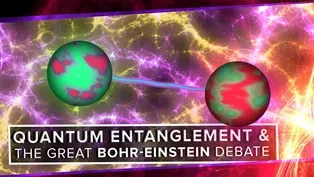
Quantum Entanglement (The Bohr-Einstein Debate)
Preview: Season 2 | 11m 24sVideo has Closed Captions
Let's settle the quantum entanglement once and for all.
Albert Einstein strongly disagreed with Niels Bohr when it came to Bohr’s interpretation of quantum mechanics. Quantum entanglement settled the argument once and for all.
Problems with Closed Captions? Closed Captioning Feedback
Problems with Closed Captions? Closed Captioning Feedback

Quantum Entanglement (The Bohr-Einstein Debate)
Preview: Season 2 | 11m 24sVideo has Closed Captions
Albert Einstein strongly disagreed with Niels Bohr when it came to Bohr’s interpretation of quantum mechanics. Quantum entanglement settled the argument once and for all.
Problems with Closed Captions? Closed Captioning Feedback
How to Watch PBS Space Time
PBS Space Time is available to stream on pbs.org and the free PBS App, available on iPhone, Apple TV, Android TV, Android smartphones, Amazon Fire TV, Amazon Fire Tablet, Roku, Samsung Smart TV, and Vizio.
Providing Support for PBS.org
Learn Moreabout PBS online sponsorship[music playing] Is there a hidden physical reality that underlies the strange behavior of the quantum world?
Or is that reality an illusion in the eye of the observer?
The weird phenomenon of quantum entanglement gives us quite startling clues to the answer.
[music playing] Babies may suck at math.
But they're actually surprisingly good at quantum mechanics.
Well, one fundamental aspect of it anyway.
The peekaboo game is thought to be so hilarious to babies because they lack object permanence.
Hide your face with your hands, and a baby won't automatically assume that you kept existing.
Reveal your face again, and it's as though you popped into existence from nothing, which is, of course, a hilarious thing to do.
Kids get over this pretty quickly as they learn that things don't magically pop into and out of existence for no reason.
By the time they grow up and go to college to study physics, the notion of object permanence is so deeply embedded that we don't even bother teaching it in physics 101.
And yet the idea that the universe keeps existing when we're not looking at it is a pretty fundamental implied assumption behind all of classical physics.
Indeed, most of science takes it for granted that the universe is real, whether or not we're looking at it.
This notion that the universe exists independent of the mind of the observer is called realism in physics.
But quantum mechanics is so bizarre that it still has scientists wondering if we need to reject even this basic premise.
This was the source of one of the most heated debates at the advent of quantum mechanics.
On the one hand, Niels Bohr insisted that it was meaningless to assign reality to the universe in the absence of observation.
In the intervals between measurement, quantum systems truly exist as a fuzzy mixture of all possible properties-- what we call a superposition of states.
In between observations, the wave function describing this superposition is a complete description of reality.
And our experience of a well-defined material universe only has meaning at the moment of measurement.
This peekaboo universe is the heart of Bohr's Copenhagen interpretation.
On the other hand, Albert Einstein insisted on an objective reality, a reality independent of our observation of it.
He insisted that the wave function, and by extension quantum mechanics, is incomplete.
There must exist what we call hidden variables that reflect a more physical underlying reality.
In an effort to demonstrate the silliness of Bohr's idea, Einstein along with Doris Podolsky and Nathan Rosen proposed a quantum scenario that showed that in order to abandon the assumption of realism, you also had to abandon a concept almost as sacred-- locality.
Locality is the idea that each bit of the universe only acts on its immediate surroundings.
This is fundamental to Einstein's relativity, which tells us that the chain of cause and effect can't propagate any faster than the speed of light.
The Einstein Podolsky Rosen, or EPR, paradox introduces one of the most mysterious ideas in quantum mechanics-- quantum entanglement.
Here's the idea.
Two particles interact briefly.
They influence each other so that their properties are somehow connected.
And yet we refrain from measuring these properties to preserve quantum uncertainty.
Quantum mechanics requires that we describe the particle pair with a single combined wave function that encompasses all possible states of both particles.
We call such particles an entangled pair.
Now, according to the Copenhagen interpretation, any measurement of one particle automatically collapses the entire entangled wave function, and so affects the results of measurements of the other particle.
That's an influence that could theoretically be transmitted instantly across any distance, and even back in time, violating locality and possibly violating causality.
Einstein et al thought this was very silly.
They thought that every special point in the universe must be real and physical and defined by knowable quantities, local hidden variables that could affect each other no faster than the speed of light.
The argument between Bohr and Einstein felt a bit philosophical at the time.
But in 1964, Irish physicist John Stewart Bell proposed an experiment to resolve the debate.
It involved entangled electron and positron pairs.
When spontaneously created from a photon, these particles will always be spinning in opposite directions to each other.
However, until measured, we can't know which direction either is spinning.
We just know that they're opposite each other.
Their wave functions are therefore entangled.
Measurement of the spin of one of these particles tells us the spin of the other, no matter how large the distance between them.
But in quantum mechanics, measurement actually affects the thing you are measuring.
In the case of quantum spin, that measurement effect is especially weird.
We define spin direction according to the spin axis.
That axis can point in any direction.
But to measure spin direction, we need to choose an axis to align our measuring device.
We always find that the observed quantum spin aligns itself with our chosen measurement axis.
If we choose to measure vertically, the spin will turn out to be up or down.
If we measure horizontally, it will be left or right.
Measurement forces the alignment of the measured particle.
But how does this affect the spin of its entangled partner?
The answer would settle the Bohr-Einstein debate.
Let me explain.
Scenario one, if Einstein was right, imagine the response of each particle to all possible spin measurements is encoded in each particle at the moment of their creation as hidden variables local to each particle.
Nothing we do later to one particle will then affect the other.
When we later measure the spins of both particles, there will be a correlation in the results because the particles were once connected.
But there'll be no correlation due to our choice of measurement axis.
Scenario two-- Bohr was right.
What if between creation and measurement, the electron and positron only exist as a wave function of all possible states.
In that case, measurement of one particle spin should cause the entire wave function to collapse, to take on defined values.
Both particles should then manifest opposite spins along whichever axis we choose for one of the particles.
That should lead to a correlation between our choice of measurement axis for the first particle and the spin direction then measured for the second.
This is exactly the spooky action at a distance that made Einstein so uncomfortable.
So John Stewart Bell figured out a set of observable results, the so-called Bell inequalities, that we'd expect to see in the case that Einstein was right and quantum mechanics needs local hidden variables.
But if an entanglement experiment violates the Bell inequalities, then local realism is also violated.
By the way, [inaudible] describes this experiment in much more detail in this video.
I recommend you check it out.
It's a tricky experiment because entangled quantum states are hard to produce, but even harder to sustain.
Any interaction can destroy the entanglement.
But in the early '80s, French physicist Alain Aspect succeeded.
Instead of looking at the entangled spins of an electron positron pair, he used photon pairs with entangled polarizations.
Polarization is just the alignment of a photon's electric and magnetic fields.
But the principle is the same.
And Aspect found that there was a correlation between the choice of polarization measurement axis for one photon and the final polarization direction of its entanglement partner.
The Bell inequalities were violated.
The experiment was even set up so that the influence had to travel between the photons at faster than the speed of light.
Since then, many experiments have verified this result over larger and larger distances.
The instantaneous influence has been observed over many kilometers at this point.
The delayed choice quantum eraser, which we already covered, is yet another example of this strange result.
It's now been thoroughly confirmed that the Bell inequalities are violated, suggesting that the wave function cannot have local hidden variables.
So does this confirm the Copenhagen interpretation and kill both locality and realism?
Do we live in a peekaboo universe that vanishes into quantum abstraction when we aren't looking at it?
Are babies really better at quantum mechanics than Einstein?
Well, not so fast.
The results of these entanglement experiments do seem to violate local realism.
But that may mean a violation of realism, or just of locality.
In fact, it was Doctor Bell's opinion that the violation of his inequalities disproved only locality.
Realism could be salvaged.
Non-locality requires that entangled particles affect each other instantaneously.
That sounds blasphemous to anyone who accepts Einstein's theory of relativity.
However, non-locality and relativity can actually be perfectly consistent.
Relativity requires that causality is preserved, so no faster than light information flow.
But none of these entanglement experiments allow any real information to be transmitted between particles.
It's only possible to see the influence between the entangled partners after measurements have been made and those measurements are compared, just as we saw with the delayed choice quantum eraser.
The universe seems to conspire to avoid the paradox of information traveling faster than light, or backwards in time.
The Copenhagen interpretation remains consistent with all quantum observations.
Niels Bohr's peekaboo universe may be the universe we live in.
However, realist and hidden variable interpretations are also consistent as long as they abandon locality.
For example, entangled particles may be dimensionally connected by Einstein-Rosen bridges, wormholes that allows instantaneous contact even between great spatial separations.
Also, the De Broglie-Bohm Pilot Wave Theory works by assuming real and non-local hidden variables.
There is even a way around all of this without sacrificing realism or locality.
That's the many worlds interpretation.
We'll get back to these in an upcoming episode of "Space Time."
Black Holes from the Dawn of Time
Video has Closed Captions
Primordial black holes may be lurking throughout our universe. (10m 16s)
Quantum Entanglement (The Bohr-Einstein Debate)
Video has Closed Captions
Let's settle the quantum entanglement once and for all. (11m 24s)
Will the Universe Expand Forever?
Video has Closed Captions
Many have tried to speculate about what the fate of the universe would be. (9m 51s)
Providing Support for PBS.org
Learn Moreabout PBS online sponsorshipSupport for PBS provided by:














